Today the children painted their own hands and made prints on their paper. Children love to finger paint. It’s fun, creative, and messy. It allows children to explore the texture of paint with their sense of touch. Plus, they feel very proud to see their own hand print on a piece of paper. Finger painting will be available for the entire week.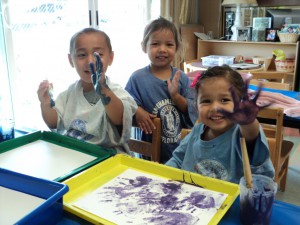
Friday, August 31, 2012
Meet the ‘Ulu class. It was a very entertaining experience to take a group shot of all of them. Out of seven different photos, this was one of the best.
Currently we have seven girls and eight boys. We are waiting for one more girl. Then we will have a full class of sixteen. It is a young class. Six children are three years old. Nine children are still two years old.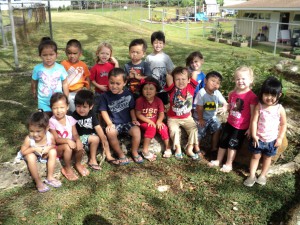
Thursday, August 30, 2012
Thank you for bringing in your red, blue, and yellow item to share. The items will go home tomorrow. The children practiced “public speaking” by sharing their items in front of the group. Sharing time also helps the rest of the children practice how to be good listeners while at large group time.
The children also practiced sorting by color. Most importantly, the children are practicing how to share the items that belong to them with other children and to also take care of (malama) items that belong to someone else.
(Note: If your child did not bring in a color item to share this time, don’t worry we will have more opportunities for sharing.)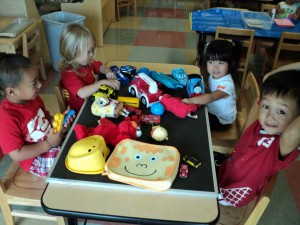
Wednesday, August 29, 2012
This week we introduced the scissors. The scissors are available for the children to use on a daily basis. First we talked about scissors safety which basically reminds the children that they are only allowed to cut paper and that they must sit down while cutting with a scissors. Then, we had the children practice cutting paper strips about 1 1/2 inches wide.
The children are at different stages of developmental scissor usage. The stages are (in lowest to highest order): 1. INTEREST in scissors, 2. ISOLATE fingers into loop, 3. OPEN-CLOSE ACTION with assistant with holding the paper, 4. RANDOM SNIPS without assistance with the paper, 5. FORWARD MOTION with an aim towards a visual goal, 6. LATERAL DIRECTION (cuts strips, across paper, on lines), 7. ANGLES (cuts simple geometric shapes: square, rectangle, semi-circle, circle), 8. COMPLEX SHAPES, and 9. CUTS NON-PAPER MATERIALS.
Whatever stage your child is at, please help them practice cutting at home (with supervision) to assist them to move to the next developmental stage. 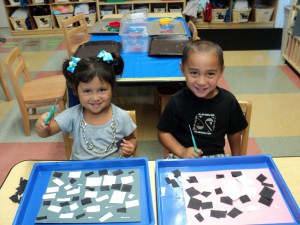
Tuesday, August 28, 2012
We practiced our first fire drill today. The alarm was very loud. But, the children did a brave job. The concept of practicing, just in case there is a real fire, is not easy for young children to grasp. One child commented, “No more fire, yah?!” But, in any school, for the safety of the children, fire drill practice is mandatory. We will have it once a month.
Monday, August 27, 2012
Today, every took a child nap. The children lay down on their mats at 11:30 and we turned on the lights at 1:15. Our average naptime will be approximately 90 minutes. Naptime is important for young children. Growing kids need lots of nourishing food, love and sleep in order to grow up healthy. What’s more, studies find that kids who nap have longer attention spans and are less fussy than those who don’t. And perhaps the best reason of all: When kids rest during the day, they tend to sleep longer and more peacefully at night
This is a picture taken at 1:15 today. It looks as though some children might have wanted a longer nap time.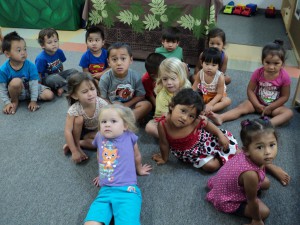
Friday, August 24, 2013
Rug Time is a time when the entire class sits together in a large group to share, read stories, sing songs, discuss social issues happening in the classroom, hear about new topics, learn skills, or to engage in a group activity. It’s a fun time and one way to build a sense of community. As important as it sounds though, sitting attentively for more than five minutes is not a naturally skill for toddlers. It requires daily practice. We use the following cues to help the children check themselves as they get ready at rug time: 1) Nana i ke kumu (Look at the teacher), 2) Ho’olohe ka pepeiao (Listen with your ears), 3) Pa’a ka waha (Close your mouth), 4) Hana ka lima (“Hands in your lap”).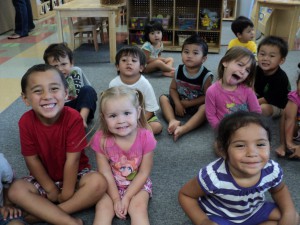
Thursday, August 23, 2012
 The ‘Ulu children are given the opportunity to paint at the easel daily. Easel painting allows children to freely explore and mix paint colors. They need time to explore the painting process and art tools before they are ready to begin painting beyond a “blob.” Preschoolers learn best by doing and an easel provides a way for students to practice several different important skills: sensory experience, social skills, motor skills, and problem solving.
The ‘Ulu children are given the opportunity to paint at the easel daily. Easel painting allows children to freely explore and mix paint colors. They need time to explore the painting process and art tools before they are ready to begin painting beyond a “blob.” Preschoolers learn best by doing and an easel provides a way for students to practice several different important skills: sensory experience, social skills, motor skills, and problem solving.
Some of the easel paintings that your child may bring home may have two names on them. This picture shows why. Children enjoy painting side-by-side. They can look and talk to each other while they paint. They must maintain personal space and control in their movements in order to work together. It creates a sense of partnership.
Wednesday, August 22, 2012
Today, we had 4 animal visitors to our classroom. Mia’s ‘ohana brought four chicks for the children to observe up close. It captivated them during our outdoor “backyard” time. The chicks will be visiting us for the rest of the week. Real animals are so fascinating to just look at. Plus, they can lead to descriptive observations and “I wonder” questions. It is important for children to ask questions because it shows that they want to learn more and it helps teachers to be more interactive in their teaching.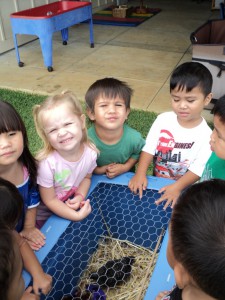
Tuesday, August 21, 2012
The children have been enjoying the sensory activities during our “backyard” time. During this time, we provide sensory activities on the lanai and in the back of our classroom. These are activities that would be considered too “messy” for the indoors. From the day children are born, they start using all of their five senses (seeing, hearing, tasting, smelling, and touching). It is the most basic way for children to explore, process, and seek new information. Children need to use their senses and be engaged in meaningful experiences. Sensory play is really part of the scientific process. They are using their senses to collect data. 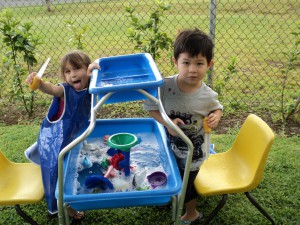
This is a picture of two children playing at the water table. The water table provides a controlled area where children can safely experiments with water and its properties.
